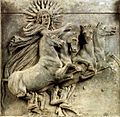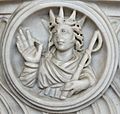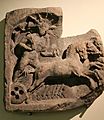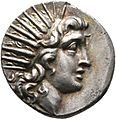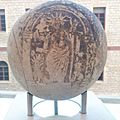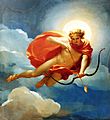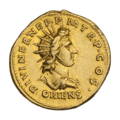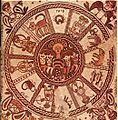Helios facts for kids
Quick facts for kids Helios |
|
|---|---|
| Personification of the Sun | |
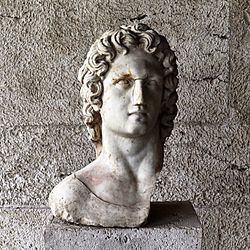
|
|
| Major cult center | Rhodes, Corinthia |
| Abode | Sky |
| Planet | Sun |
| Animals | Horse, rooster, wolf, cattle |
| Symbol | Sun, chariot, horses, aureole, whip, heliotropium, globe, cornucopia, ripened fruit |
| Tree | Frankincense, poplar |
| Day | Sunday (hēméra Hēlíou) |
| Mount | A chariot driven by four white horses |
| Gender | Male |
| Festivals | Haleia |
| Personal information | |
| Consort | Many including: Clymene, Clytie, Perse, Rhodos, and Leucothea |
| Children | Achelous, Acheron, Actis, Aeëtes, Aex, Aegiale, Aegle, Aetheria, Aethon, Aloeus, Astris, Augeas, Bisaltes, Candalus, Cercaphus, the Charites, Chrysus, Cheimon, Circe, Clymenus, the Corybantes, Cos, Dioxippe, Dirce, Eiar, Electryone, Helia, Hemera, Ichnaea, Lampetia, Lelex, Macareus, Mausolus, Merope, Ochimus, Pasiphaë, Perses, Phaethon, Phaethusa, Phasis, Phoebe, Phorbas, Phthinoporon, Sterope, Tenages, Theros, Thersanon and Triopas |
| Parents | Hyperion and Theia |
| Siblings | Selene and Eos |
| Equivalents | |
| Roman equivalent | Sol, Sol Invictus |
| Norse equivalent | Sól |
| Etruscan equivalent | Usil |
| Hinduism equivalent | Surya |
| Canaanite equivalent | Shapash |
| Mesopotamian equivalent | Utu |
| Egyptian equivalent | Ra |
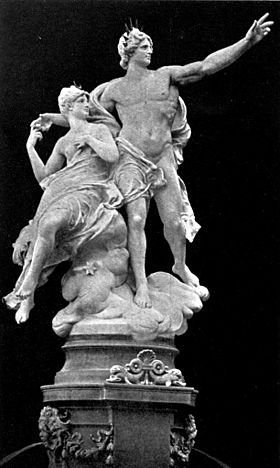
Helios (Ancient Greek: Ἥλιος, Hēlios; Ἠέλιος in Homeric Greek) is the god of the Sun in Greek mythology. He is the son of the Titans Hyperion and Theia. He has two sisters, Selene, goddess of the Moon, and Eos, goddess of the dawn. Helios' equivalent in Roman mythology was Sol.
Helios is often depicted in art with a radiant crown and driving a horse-drawn chariot through the sky.
Contents
Mythology
God of the Sun
In the Iliad Hera who supports the Greeks, makes Helios set earlier than usual during battle, and later, after her son Memnon was killed, she made him downcast, causing his light to fade, so she could be able to freely steal her son's body undetected by the armies.
While Heracles was travelling to Erytheia to retrieve the cattle of Geryon for his tenth labour, he crossed the Libyan desert and was so frustrated at the heat that he shot an arrow at Helios, the Sun. Almost immediately, Heracles realized his mistake and apologized profusely; In turn and equally courteous, Helios granted Heracles the golden cup which he used to sail across the sea every night, from the west to the east because he found Heracles' actions immensely bold. Heracles used this golden cup to reach Erytheia, and after he had taken Geryon's cattle, returned it back to its owner.
Awarding of Rhodes
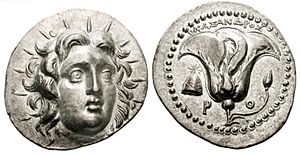
When the gods divided the earth among them, Helios was absent, and thus he got no land. He complained to Zeus about it, who offered to do the division again, but Helios refused the offer, for he had seen a new land emerging from the deep of the sea; a rich, productive land for humans and good for cattle too. Helios asked for this island to be given to him, and Zeus agreed to it. An alternative version says it was Helios himself who made the island rise from the sea. He named it Rhodes, after his lover Rhode (the daughter of Poseidon and Aphrodite or Amphitrite), and it became the god's sacred island, where he was honoured above all other gods.
Phaethon
Helios' most notable role in Greek mythology is the story of his mortal son Phaethon who asked his father for a favour; Helios agreed, but then Phaethon asked for the privilege to drive his four-horse fiery chariot across the skies for a single day. Although Helios warned his son again and again against this choice, explaining to him the dangers of such a journey, Phaethon was hard to deter, and thus Helios handed him the reins. As expected, the ride was disastrous, and Zeus struck the youth with one of his lightning bolts to stop him from burning or freezing the earth.
The Watchman
Persephone
Helios saw and stood witness to everything that happened underneath him where his light shone. When Hades abducted Persephone, Helios, was the only one to witness it. Persephone's mother Demeter, looked far and wide in search of her daughter, and came to him, and asked him if he had seen anything. Helios, sympathizing with her grief, told her in detail that it was Hades who, with Zeus' permission, had taken an unwilling Persephone to the Underworld to be his wife and queen.
Leucothoe and Clytie

Aphrodite made Helios fall for a mortal princess named Leucothoe, forgetting his previous lover nymph Clytie. Helios would watch Leucothoe from above, even making the winter days longer so he could have more time looking at her. Taking the form of her mother Eurynome, Helios entered their palace with no problem and came into the girl's room where he dismissed her servants so he would be left alone with her, using the excuse of wanting to entrust a secret to his "daughter". There he took his real form, revealing himself to the girl.
However, Clytie, still in love with him, informed Leucothoe's father Orchamus of this affair, and he buried Leucothoe alive in the earth. Helios came too late to rescue her, his grief over her death compared to the one he had over Phaethon's fiery end, and could not revive her, so instead he poured nectar into the earth, and turned the dead Leucothoe into a frankincense tree, so that she could still breathe air instead of rotting beneath the soil. Clytie had hoped that this would get Helios back to her, but he wanted nothing to do with her, angered about the role she played in his love's death, and went on his way. Clytie then sat on a rock for nine days, accepting no food or drink, and pining after him; he never looked back at her. Eventually she turned into a purple, sun-gazing flower, the heliotrope, which follows Helios' movement in the sky, still in love with him; her form much changed, her love unchanged.
Clytie's herb has been identified with the purple heliotropium, however people from the Middle Ages onwards have supplanted it with the yellow sunflower in retellings, commentaries and artwork, even though in the story Ovid describes it as purple, or "like a violet". Moreover, sunflowers are native to North America, not Greece or Italy, so it is unlikely ancient writers would have been familiar with it.
Consorts and children
The god Helios is the head of a large family. Traditionally the Oceanid nymph Perse was seen as the sun god's wife. Together they had various children. However he is also stated to have married other women like Rhodos in the Rhodian tradition by whom he had seven sons.
| Consort | Children | Consort | Children | Consort | Children | ||
|---|---|---|---|---|---|---|---|
| Athena | • The Corybantes | Rhodos (a nymph) |
• The Heliadae | Ephyra (an Oceanid) |
• Aeëtes | ||
| Aegle, (a Naiad) |
• The Charites | 1. Tenages | Antiope | • Aeëtes | |||
| 1. Aglaea "splendor" |
2. Macareus | • Aloeus | |||||
| 2. Euphrosyne "mirth" |
3. Actis | Crete | • Pasiphaë | ||||
| 3. Thalia "flourishing" |
4. Triopas | Gaia | • Bisaltes | ||||
| Clymene (an Oceanid) |
• The Heliades | 5. Candalus | • Achelous | ||||
| 1. Aetheria | 6. Ochimus | Hyrmine or | • Augeas | ||||
| 2. Helia | 7. Cercaphus | Iphiboe or | |||||
| 3. Merope | 8. Auges | Nausidame | |||||
| 4. Phoebe | 9. Thrinax | Demeter or | • Acheron | ||||
| 5. Dioxippe | • Electryone | Gaia | |||||
| • Phaethon | Perse (an Oceanid) |
• Calypso | unknown woman | • Aethon | |||
| • Astris | • Aeëtes | unknown woman | • Aix | ||||
| • Lampetia | • Perses | unknown woman | • Aloeus | ||||
| Rhode (a Naiad) |
• Phaethon | • Circe | unknown woman | • Camirus | |||
| Prote (a Nereid) |
• Pasiphaë | unknown woman | • Ichnaea | ||||
| • The Heliades | • Aloeus | unknown woman | • Mausolus | ||||
| Neaera (perhaps an Oceanid) |
• Phaethusa | Asterope | • Aeëtes | unknown woman | • Phorbas | ||
| • Lampetia | • Circe | unknown woman | • Sterope | ||||
| Ocyrrhoe (an Oceanid) |
• Phasis | Ceto (an Oceanid) |
• Astris | unknown woman | • Eos | ||
| Leda | • Helen | Leucothoe or | • Thersanon | unknown woman | • Selene | ||
| Clytie (an Oceanid) |
• No known offspring | Leucothea | unknown woman | • Hemera | |||
| Selene | • The Horae (possibly) |
unknown woman | • Cronus (Orphic) |
unknown woman | • Dirce | ||
| unknown woman | • Aeëtes | unknown woman | • Clymenus | unknown woman | • Lelex | ||
| • Perses | unknown woman | • Chrysus | unknown woman | • Aegiale | |||
| unknown woman | • Cos |
Namesakes
Helius is a genus of crane fly in the family Limoniidae that shares its name with the god.
A pair of probes that were launched into heliocentric orbit by NASA to study solar processes were called Helios A and Helios B after this god.
Interesting facts about Helios
- Helios is a god who both sees and hears everything, who can spy among gods and mortal men alike, and thus was often invoked in oaths.
- He also played a significant part in ancient magic and spells.
- The Roman Emperor Julian made Helios the central god in the 4th century AD.
- Helios was seen as a god driving his chariot from east to west each day. People believed that summer days are longer due to Helios often stopping his chariot mid-air to watch nymphs dancing during the summer.
- One of the craters of Hyperion, a moon of Saturn, is named after Helios.
- The chemical element Helium was named after Helios by Norman Lockyer and Edward Frankland.
- The Colossus of Rhodes, a gigantic statue of Helios, adorned the port of Rhodes until it was destroyed in an earthquake.
Images for kids
-
Helios relief (1830), Stuttgart, Rosenstein Castle.
-
Helios in front of Mithras, fresco from a Mithraeum, Hama museum, Syria.
-
Hera makes Helios set earlier, Iliad engraving, John Flaxman.
-
Helios rising in his chariot, red-figure calyx-krater, 430 BC (circa), British Museum.
-
Phaethon meets the Sun, engraving for the Metamorphoses.
-
Helios and Phaethon with Saturn and the Four Seasons, by Nicolas Poussin, oil on canvas
-
Blind Orion Searching for the Rising Sun, by Nicolas Poussin, 1658, oil on canvas
-
Helios and chariot depicted on the dome of the entrance hall of the Széchenyi Bath, Budapest
-
Bust of Helios in a clipeus, detail from a strigillated lenos sarcophagus, white marble, early 3rd century CE, Tomb D in Via Belluzzo, Rome.
-
Silver drachma coin from Rhodes island with the head of Helios looking to the right and bearing a diadem of rays, ca. 170-150 BC, University of Tübingen, Berlin.
-
Quadriga of the Sun, sixth century BC, Temple C, Selinunte.
-
The Temple of Garni, late first century, Armenia, dedicated to the solar god Helios-Mihr, from a syncretic Helleno-Armenian cult.
-
Magical sphere with Helios and magical symbols from the theatre of Dionysus, Acropolis Museum, Athens.
-
Coin of Roman Emperor Constantine I depicting Sol Invictus/Apollo with the legend SOLI INVICTO COMITI, c. 315 AD.
-
Bust of Alexander the Great as an eidolon of Helios (Musei Capitolini).
-
Helios as the personification of midday, renaissance painting by Anton Raphael Mengs (c. 1765) showing apollonian traits, such as the lack of a chariot, that were absent in mythology and Hellenic art.
-
Helios in the Sun chariot accompanied by Phosphorus and Hermes, fresco at Nymphenburg Palace, Munich.
-
Serapis with Moon and Sun, oil lamp, Roman terracotta, British Museum.
-
Helios witnessing the birth of Athena, detail from the pediment (far-left) of the Academy of Athens, by Leonidas Drosis, Greece.
-
Sol in the east side of the Arch of Constantine, Rome.
-
Helios in the Hammat Tiberias mosaic, Israel.
-
Apollo fountain in the Palace of Versailles, France.
-
Apollo in the Forge of Vulcan, by Diego de Velázquez, oil on canvas.
-
Helios in one of the many stamps issued in 1947-53, celebrating the unification of the Dodecanese with Greece
-
Odysseus' men eat the oxen, as a woman informs Helios, mounted on his chariot, engraving by Theodoor van Thulden, 1632–1633, Rijksmuseum, Netherlands.
See also
 In Spanish: Helios para niños
In Spanish: Helios para niños






